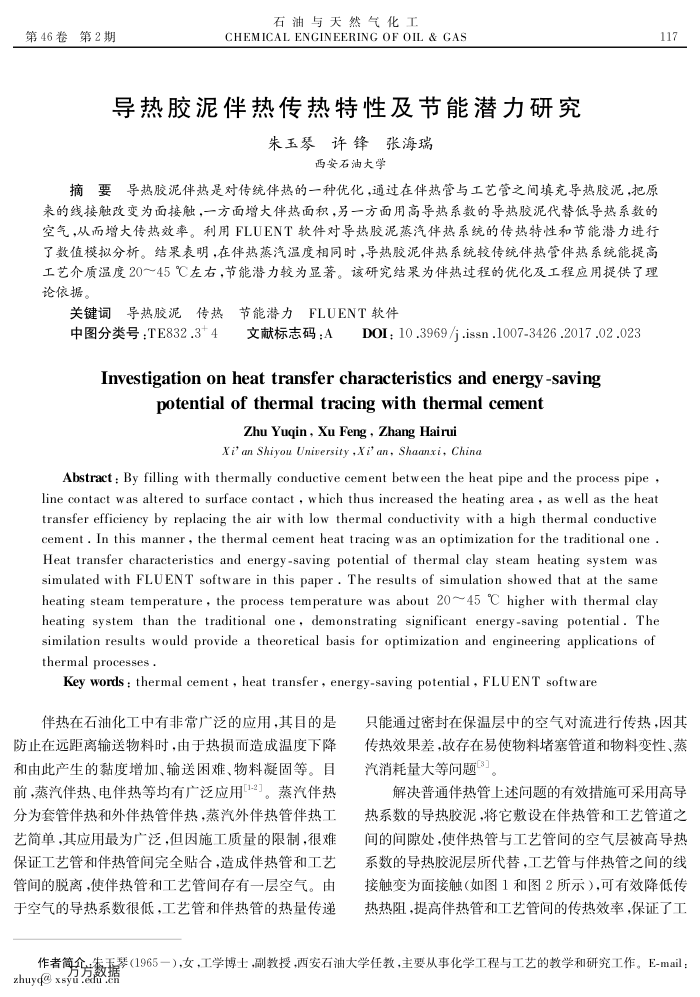您当前的位置:首页>论文资料>导热胶泥伴热传热特性及节能潜力研究
内容简介
 第46卷第2期
第46卷第2期石油与天然气化工
CHEMICAL ENGINEERING OF OIL & GAS
导热胶泥伴热传热特性及节能潜力研究
朱玉琴许锋张海瑞
西安石油大学
摘要导热胶泥伴热是对传统伴热的一种优化,通过在伴热管与工艺管之间填充导热胶泥,把原来的线接触改变为面接触,一方面增大伴热面积,另一方面用高导热系数的导热胶泥代替低导热系数的了数值模拟分析。结果表明,在伴热蒸汽温度相同时,导热胶泥伴热系统较传统伴热管伴热系统能提高工艺介质温度20~45℃左右,节能潜力较为显著。该研究结果为伴热过程的优化及工程应用提供了理论依据。
关键词导热胶泥传热节能潜力FLUENT软件中图分类号:TE832.3+4
文献标志码:A
DOI:10.3969/j.issn.1007-3426.2017.02.023
Investigation on heat transfer characteristics and energy-saving
potential of thermal tracing with thermal cement
Zhu Yuqin, Xu Feng , Zhang Hairui
Xi'an Shiyou Unirersity,Xi' an, Shaanxi, China
117
Abstract:Byfilling with thermally conductive cement between the heat pipe and the process pipe, line contact was altered to surface contact , which thus increased the heating area , as well as the heat transfer efficiency by replacing the air with low thermal conductivity with a high thermal conductive cement . In this manner , the thermal cement heat tracing was an optimization for the traditional one . Heat transfer characteristics and energy-saving potential of thermal clay steam heating system was simulated with FLUENT software in this paper . The results of simulation showed that at the same heating steam temperature , the process temperature was about 20~45 C higher with thermal clay heating system than the traditional one, demonstrating significant energy-saving potential. The similation results would provide a theoretical basis for optimization and engineering applications of thermal processes.
Key words: thermal cement, heat transfer,energy-saving potential, FLUENT software
伴热在石油化工中有非常广泛的应用,其目的是防止在远距离输送物料时,由于热损而造成温度下降和由此产生的黏度增加、输送困难、物料凝固等。目前,蒸汽伴热、电伴热等均有广泛应用1-2」。蒸汽伴热分为套管伴热和外伴热管伴热,蒸汽外伴热管伴热工艺简单,其应用最为广泛,但因施工质量的限制,很难保证工艺管和伴热管间完全贴合,造成伴热管和工艺管间的脱离,使伴热管和工艺管间存有一层空气。由于空气的导热系数很低,工艺管和伴热管的热量传递
只能通过密封在保温层中的空气对流进行传热,因其传热效果差,故存在易使物料堵塞管道和物料变性、蒸汽消耗量大等问题3]
解决普通伴热管上述问题的有效措施可采用高导热系数的导热胶泥,将它敷设在伴热管和工艺管道之间的间隙处,使伴热管与工艺管间的空气层被高导热系数的导热胶泥层所代替,工艺管与伴热管之间的线接触变为面接触(如图1和图2所示),可有效降低传热热阻,提高伴热管和工艺管间的传热效率,保证了工
作者简参琴(1965一),女,工学博士,副教授,西安石油大学任教,主要从事化学工程与工艺的教学和研究工作。E-mail: zhuyxs久数摄